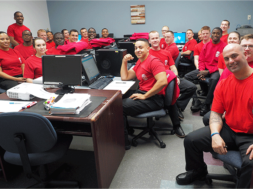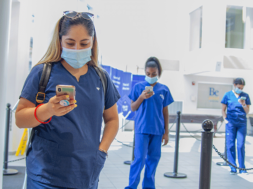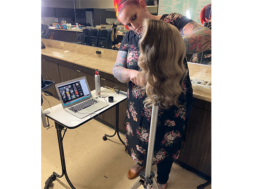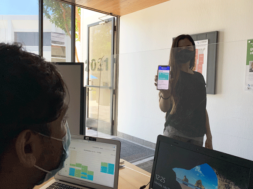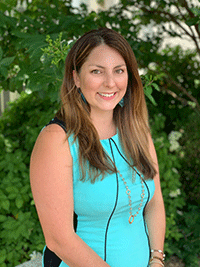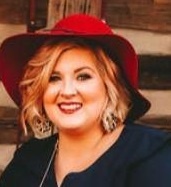
Successful Transition to Online Learning Amid a Pandemic
By Holly Puckett DNP, RN, CMSRN, Academic Director, Centra College and Susan Motto Burnette, MSN, RN, RN-BC, Faculty Instructor and Student Health Nurse, Centra College
Background: Centra College previously known as Centra College of Nursing and originally known as Lynchburg General School of Nursing, was founded in 1912. Centra College has been accredited by the Accrediting Bureau for Health Education Schools (ABHES) since 2013. What was originally a school for diploma nurses has now grown into a college that offers an academic progressive model.
This opportunity provides students the option to start in the Nurse Aide program and work their way through the Practical Nursing Program, Associated Degree of Nursing Program, and lastly the RN-BSN program.
Centra College is governed and affiliated with the parent organization, Centra Health, Inc. (Centra). Centra has four main hospitals that serve the Central Virginia area. In addition to the four acute care facilities within the Centra Organization, there are numerous outpatient and rehabilitation settings that are available for the Centra College student clinical sites. There are two additional universities in the area that offer health sciences majors, however, they do not offer the progressive nursing education model.
Pre-pandemic: Centra College has been a traditional brick and mortar school of nursing. In March of 2020, the COVID pandemic impacted the entire United States and most of the country, including institutions of higher learning, were mandated to shut down. Like Centra College, there were many brick and mortar intuitions scrambling on how to best educate their students. Aside from completely shutting down, there was only one option to keep students, faculty, and staff safe – switching the mode of delivery to distance education learning.
Pandemic: When the pandemic began, and the world began shutting down, Centra College was on spring break. In preparation for transitioning to the distance education model of nursing education, the student’s spring break was extended for one week. During this time, faculty worked together with the different departments within the college to develop a plan of action. This plan of action had to be quickly constructed and carefully thought out because it was not only going to affect the students enrolled in the spring semester and possibly those in future semesters, but their nursing practice and patient outcomes for years to come.
Development of a plan to switch to distance education took a cohesive team made up of administrators, staff, faculty, technology experts, along with vendors whom we work with for tasks such as student testing, simulation, etc. Decisions such as synchronous vs asynchronous curriculum, how to conduct clinical when students are not allowed in the hospital or the variety of outpatient settings we use, and how to proctor students virtually had to be considered. Once all the options were weighed and each course was set up for online learning on the learning management system, the team chose to go with the asynchronous model of delivery for the first semester. This allowed students flexible time for their classwork, virtual simulation, testing, and management of their personal life in unprecedented times. While there has been research and resources provided on the efficiency of distance learning education, teaching clinical and practicum virtually was an entirely different scenario as it had to meet the requirements of the State Board of Nursing. Undergraduate nursing clinical and practicum in-person has been the same method for decades as nursing programs rely on clinical affiliates for clinical placement of students to learn the applicable skills for nursing practice (Konrad, Fitzgerald, & Deckers, 2021).
Once the ball was rolling with the asynchronous curriculum, the faculty was hard at work putting resources together for students.
The team worked long hours transforming the learning management system (Moodle) to align with an asynchronous curriculum and add activities and resources for student interaction. Most popularly used were voice-over PowerPoints and discussion boards for various concepts the students were learning. While students were excelling with the transition, faculty felt the magnetic pull to up the ante and provide resources that increased engagement. Centra was able to acquire Microsoft Teams for the college, which was very helpful in allowing students, faculty, and staff to communicate and see each other without being in person. For future semesters we knew that continuing with an asynchronous curriculum would be a challenge; there is an element to nursing education that thrives in a live learning environment.
The hope of COVID being eradicated by summer 2020 was short lived and we had to act with a purpose for our summer and fall semester students. The summer semester and fall semesters were a pivotal moment because we knew at this point our pre-licensure practical nursing and associate degree of nursing students would be spending half of their degree program learning the didactic part of their program via online learning. While the thought of educating the students and ensuring they were ready for practice outside of classroom walls was daunting, it also provided an opportunity for innovation and change (Williamson, Nininger, Dolan, Everett, Joseph-Kemplin,2021). During the summer and fall semesters, students were able to return to in-person skills labs and clinical/practicum following strict COVID-19 screenings and protocols, however, didactic was still to be delivered via distance education. As the faculty, staff, and administration worked together to plan another semester of online learning, we decided to flip the mode of online learning from asynchronous to synchronous to incorporate classes at set times of each week and allow for proctored testing. At this point in the pandemic, we had the opportunity to allow students to plan for childcare, work, and other personal needs so that they could attend class and proctored tests at the assigned times. Synchronous classes gave students the ability to engage with their peers, ask questions of their instructors, and engage in classroom learning activities. The goal of the instructor is to ultimately engage students in the learning process (Jowsey, Foster, Cooper-Ioelu, & Jacobs, 2020).
Tips, tricks, and viable resources: Active learning encourages participation, student engagement, and allows students to actively construct knowledge (Jowsey et. al, 2020). While participation and engagement can be difficult online, it can be implemented and provided well. There are numerous budget-friendly resources that you can imbed in your PowerPoint presentations such as Slido. Slido allows you to create the opportunity to ask questions and for the students to answer in real-time in many different formats such as multiple choice, select all that apply, or fill in the blank. Students answer using their computer, iPad, tablet, or cellular device. Like Slido, Poll Everywhere can also be embedded in your PowerPoint and allows students to answer in real-time on their cellular devices, however, it does not allow for select all that apply answers to questions. Another active learning activity is Kahoot!. Kahoot! is a web-based platform that allows for the instructor or even students to make a game with course content. There are free and paid versions of Kahoot!. Often Kahoot! is used by the instructor in class as a quiz or simply just for fun. The students enter the game code on their computer or mobile device and answer the questions on their device. Kahoot! keeps score, plays music, has a leader board, and boasts bright colors. Students who are competitive in class tend to like this activity. The paid version of Kahoot! allows for instructors to go back and review the metrics of their quizzes. They can see which questions were missed by students so they can review and reinforce the content with them if needed.
In addition to polling, question and answer games, there are also additional resources for engagement such as virtual escape rooms.
Virtual escape rooms are a relatively new concept but have gained popularity throughout the pandemic and online learning. Virtual escape rooms can be built using programs such as Microsoft One Note where the creator makes a content-based puzzle that the student must figure out the answer in order to unlock the next page of the escape room. Students can use escape rooms in both the synchronous and asynchronous modes of online education. Microsoft Teams’ break-out rooms during synchronous delivery is also an excellent tool for group work.
One-year post-pandemic: One year later, COVID-19 has changed the world around us. Centra College is still thriving and continuing to educate healthcare students. In the hustle and bustle of ensuring we were able to move to an online curriculum and confirming students were able to meet clinical hour requirements, we had worries of decreased enrollment and retention. Enrollment and retention maintained viability. Our students were gradually able to return to clinical areas in the summer and fall of 2020, and currently are 99% back to their usual clinical sites. As we have progressed through this pandemic, our institution has maintained didactic in a virtual environment. However, undergraduate nursing is best taught in-person as the student nurse must gain confidence and competence with nursing skills for the clinical setting. As COVID-19 cases decline, we expect our students and faculty to return full-time in a residential mode of delivery for didactic. Due to the partnership we share with Centra Health, we have been able to offer our students COVID vaccines and many of them have now been vaccinated.
The online mode of pre-licensure nursing education has been challenging and has been a grand learning experience for the faculty, staff, and all involved, but has also enabled us to find opportunities during this time of crisis. Each day there have been resources shared, something new learned, or a new activity created. Collectively our team has worked hard not only to ensure the retention of students, but to provide support such as mental health services. Most importantly, students are receiving quality nursing education that will impact the future of healthcare for years to come.
Resources for Student Engagement Activities
-
- Slido – Audience Interaction Made Easy – https://www.sli.do/
- Picmonic – Free or Paid Visuals to go along with course content – https://www.picmonic.com/
- Quizwhizzer – create a game board for students with your content – free or paid versions – https://quizwhizzer.com/
- Poll Everywhere – Host interactive remote meetings – https://www.polleverywhere.com/
- Educreations – Make your own video- free and paid – https://www.educreations.com
- Kahoot! – Play from anywhere! – Kahoot.it
- NearPod – allows instructor to add questions to PowerPoints, YouTube videos, etc. – https://nearpod.com/teach-2
HOLLY PUCKETT serves as the Academic Director at Centra College. She has 11 years of experience in medical-surgical nursing and four years of experience in nursing education. She received her Bachelor of Science in Nursing from George Mason University, her Master of Science in Nursing from South University and now has received her Doctorate in Nursing Practice from South University. She received her Medical-Surgical Registered Nurse certification in 2014 and is a member of the Academy of Medical Surgical Nurses and National League for Nursing. She has taught in the baccalaureate, the associate degree and practical nursing levels in distance and residential modes of delivery.
In her current role, she is responsible for providing supervision and management for faculty, staff and students in an associate and baccalaureate program at Centra College. Holly serves as a resource for the faculty and staff with technology, teaching strategies, and data management through accreditation. Holly still instructs in the classroom for various topics throughout the associate degree program such as nursing research, evidence-based practice, and nursing leadership.
She is passionate about both nursing practice and education. Holly’s areas of expertise are leadership, research, and medical-surgical nursing. She is a mother to a 6-year-old boy and a 1-year-old boy and has been married to her husband for seven years. Holly enjoys baking, scrapbooking, and all things outdoors.
Contact Information: Holly Puckett DNP, RN, CMSRN // Academic Director // Centra College // 434-200-5302 // holly.puckett@centracollege.edu // www.centracollege.edu // facebook.com/centracollege
SUSAN BURNETTE serves as a Faculty Instructor and Student Health Nurse at Centra College. She has 12 years of medical-surgical nursing, three years of public health, and seven years of experience in nursing education. She received her Associate Degree of Applied Science in Nursing from Virginia Western Community College and her Bachelor of Science in Nursing, along with her Master of Science in Nursing from American Sentinel University. She received her ANCC Medical-Surgical Nursing certification in 2015. She has taught nurse aide, practical nursing, and at the associate degree level.
In her current role, she is responsible for didactic and clinical instruction at the associate degree level. She is also a student advisor and recruitment committee chair. In the role of student health nurse, she maintains health records for all students enrolled, responds to any medical emergencies on campus, and fields any student health questions or concerns.
She has a passion for nursing education and practice. Currently, she still practices on a medical-surgical floor during academic breaks. Susan’s areas of expertise are education, leadership, and medical-surgical nursing. She is a mother to two girls, ages four and eight. She has been married to her husband for 11 years. Susan enjoys spending time with her family and friends, days on Smith Mountain Lake, and watching her kids play sports.
Contact Information: Susan Motto Burnette MSN, RN, RN-BC // Faculty Instructor and Student Health Nurse // Centra College // 434-200-7026 // susan.burnette@centracollege.edu // facebook.com/centracollege




